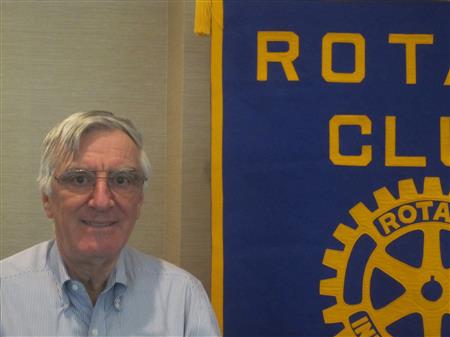Military Air Rescue Stories presented by Marc Liebman, Capt. USN (ret)
Marc Liebman, naval aviator and author, visited the Rotary Club to tell of some of his experiences during about 3,800 hours flying rescue helicopters built by the lowest bidder under some of the worst conditions.
Liebman flew rescue missions during the Viet Nam, Desert Shield and Desert Storm conflicts. He flew a variety of helicopters from the decks of specially prepared naval destroyer ships. A platform about the size of the helicoptor was built on the tail section of the ship. The pilot’s job was to get the heavily loaded aircraft off the rolling, pitching pad during takeoff and place it safely down during landing, day or night, good weather or bad. It was the hardest thing he ever did and it was repeated every flight.
The aircrews flying bombing or fighter missions were assured by a copter like Lieberman’s hovering close enough to help them if they were shot down. In one case Lieberman was on station in the northern Gulf of Tonkin when they were alerted that an F4 Phantom crew of two had parachuted into Haiphong harbor, North Viet Nam’s busiest seaport. Liberman and his crew flew in and identified the airmen’s location. The F4’s radar intercept officer indicated the pilot was injured so one of the rescue crewmen went in the water and secured him. Then they rescued the other airman and began their escape. All of this time they were under fire from nearby ships. Just another day in the search and rescue business.
Lieberman said that the worst resistance they ever had resulted in the saving of a Marine platoon but a helicopter with over 250 bullet holes. Air rescue crews are among the bravest service members because they know every mission will involve a high probability of contact with the enemy. If there were no danger they would not have been needed. Lieberman’s proudest achievement was that he never lost one of his crewmen and only one was wounded. An achievement indeed under these conditions.
Lieberman has written several novels explaining some of his experiences. They allow him to tell the stories without naming names. For more information about the books visit his web site at www.marclieberman.com .
For more information about the Rotary Club of Waxahachie where we believe in Service Above Self and doing things as a club we cannot do alone, visit the club web site at www.waxahachierotary.org . You can find American flag subscription forms there
Download the website sponsorship guide






